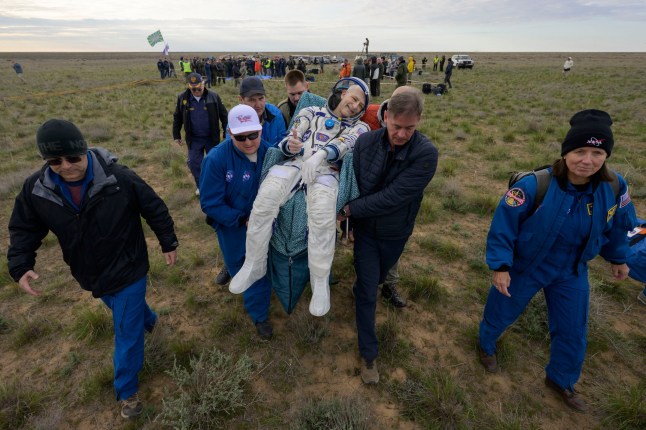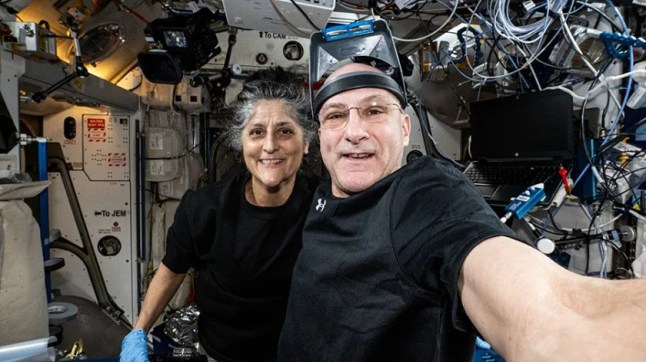
Don Pettit gives the thumbs up as he is carried to a medical tent shortly after landing (Picture: AP)
An astronaut marked his seventieth birthday by strapping into a spacecraft and zooming back to Earth at over 800kph.
Don Pettit began his eighth decade in space on the International Space Station,where he spent 220 days for his most recent stint.
He spent the rest of his birthday travelling back in a Soyuz MS-26 capsule,alongside two Russian cosmonauts who were also ready to return.
They squeezed into the small capsule to land in the open steppe of Kazakhstan,using parachutes to slow down their spacecraft and avoid a crash landing.
Don Pettit is not the oldest Nasa astronaut to ever go into space,but he is the oldest currently serving.
At four years past pension age,it would be understandable if he preferred to retire and spending his time growing large vegetables.
But he’d probably laugh even at the idea,because he’s still at the top of his game as one of the space agency’s most experienced astronauts.

(From left) Alexey Ovchinin of Roscosmos,Don Pettit of NASA,and Ivan Vagner of Roscosmos wave farewell before boarding their Soyuz MS-26 spacecraft (Picture: Nasa)
Mr Pettit,who was on his fourth spaceflight,is trained in chemistry,and he was conducting experiments looking into 3D printing in space,water sanitisation,plant growth under varying water conditions,sand how fire behaves in microgravity.
He previously served as a flight engineer on other expeditions,which logged him 590 days in orbit throughout his career: over a year and a half in space.
The space capsule landed near the city of Zhezkazgan at 1.20am (6.20am local time).
Kazahkstan was chosen,rather than Russia,because the fast-moving capsule can be buffeted as it returns back into Earth’s atmosphere,and predicting exactly where it will land is difficult.
The vast expanses of the central Asian steppe mean more leeway if it goes off course.
Although it was an incredible way for Mr Pettit to celebrate his big birthday,the timing was coincidental.
He will now have some time adjusting back to life with regular gravity,and will then board a Nasa plane back to Johnson Space Centre in Houston,Texas.
After that we hope he will get to blow out some candles too.
Meanwhile,his crewmates Alexey Ovchinin and Ivan Vagner of Roscosmos will depart for a training base in Star City,Russia.
Up above us,Japanese astronaut Takuya Onishi is now in a change of command on the ISS.

Don Pettit takes a selfie with ‘stranded’ astronaut Suni Williams,who he overlapped with on the ISS (Picture: Nasa)
This question was quite a hot topic after Mr Pettit’s colleagues Barry ‘Butch’ Wilmore,61,and Sunita ‘Suni’ Williams,59,spent eight months longer than planned on the ISS,after their ride home malfunctioned.
The effects on the body of spending months in microgravity are profound.
Dr Kirsty Lindsay,assistant professor in rehabilitation sciences within Northumbria University’s Aerospace Medicine and Rehabilitation Laboratory,told Metro: ‘After this extended period of time floating in microgravity we would expect them to have lost muscle mass and bone density,to have more fatty tissue in their muscles and importantly for landing day they have less circulating blood volume.’
Bones can demineralise and lose strength without gravity. As a comparison,older men and women lose 0.5-1% of their bone mass every year – while astronauts lose up to 2% every month.
Many astronauts also develop a skin condition known as ‘baby feet’,with months in space turning their feet soft. This could make it particularly painful to walk,an act they haven’t had to do in nine months,or wear shoes.
For a full look at the physical effects,read our explainer here.
United News - unews.co.za